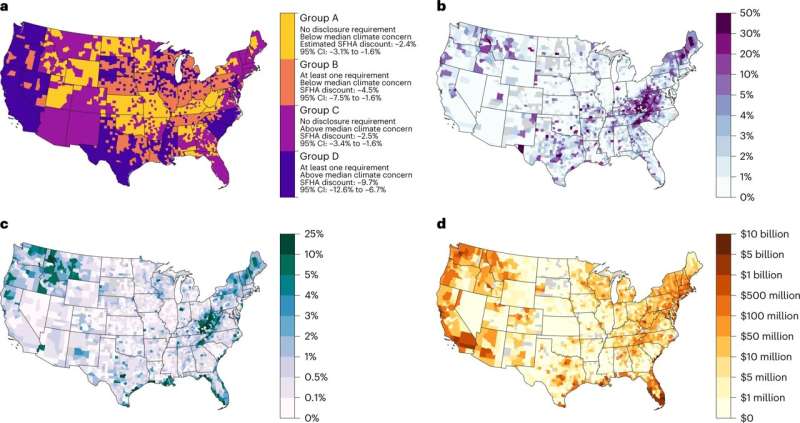
Flood risk capitalization and property overvaluation by county. a, Estimated flood zone property price discount, differentiated by flood risk disclosure laws and attitudes towards climate change. b, Median property-level overvaluation, as a proportion of properties’ current fair market value. c, Property overvaluation as a proportion of the total fair market value of all properties. d, Total overvaluation in dollars. Credit: Nature Climate Change (2023). DOI: 10.1038/s41558-023-01594-8
A new study published in the journal Nature Climate Change examines the potential cost of unrealized flood risk in the American real estate market, finding that flood zone property prices are overvalued by $121–$237 billion.
Authored by researchers from Environmental Defense Fund, First Street Foundation, Resources for the Future, the Federal Reserve, and several academic institutions, the study also examined how unpriced flood risk throughout the country could impact communities and local governments, finding low-income households particularly vulnerable to home value deflation.
“Increasing flood risk under climate change is creating a bubble that threatens the stability of the US housing market. As we’ve seen in California in the last few weeks, these aren’t hypotheticals and the risk is more extensive than expected—and that risk carries an enormous cost,” said Jesse Gourevitch, a postdoctoral fellow at Environmental Defense Fund and lead author of the study.
“These risks are largely unaccounted for in property transactions, encouraging development in flood-prone areas. Accurately pricing the costs of flooding in home values can support adaptation to flood risk, but may leave many worse off.”
Currently, more than 14.6 million properties in the United States face at least a 1 percent annual probability of flooding, with expected annual damages to residential properties exceeding $32 billion. Increasing frequency and severity of flooding under climate change is predicted to increase the number of properties exposed to flooding by 11 percent and average annual losses by at least 26 percent by 2050.
The increasing cost of flooding under climate change has led to growing concerns that housing markets are mispricing these risks, thus causing a real estate bubble to develop.
2023-03-05 20:11:55
Source from phys.org
A recent study conducted by First Street Foundation, a non-profit research organization, has highlighted the significant impact of unpriced climate risks on the US housing market. The study reveals that the US housing market is overvalued by approximately $200 billion due to insufficient consideration of the risks posed by flooding and sea-level rise.
The research team analyzed twenty-five million property records from across the country to determine the effect of climate change on property values. Their findings indicated that housing prices in risky flood areas were lower than in low-risk areas, as expected. Still, the difference was much smaller than the actual risks posed by climate change. The study showed that the risk of floods and rising sea levels is more significant than previously assumed, leading to the undervaluation of the actual risk, and fundamentally influencing real estate demand, supply, and pricing.
The report also emphasizes the imbalance between the insurance industry and real estate industry concerning climate risk. The report states that insurance companies have priced the cost of damages according to climate risks and, as a result, refuse to insure most properties located in high-risk areas. Still, the housing market’s price mechanisms have not accounted for these risks.
The study’s results challenge traditional risk-premium models that insurers and lenders typically use to quantify the risks and premiums to charge for potential damages. The report indicates that this current modelling practice of pricing risk premiums based on a historical record of natural disasters and human behaviour may not adequately incorporate the long-term risks associated with climate change, leading to implications for investors, lenders and developers alike.
The research findings suggest that properties that are prone to flood and proximity to the sea should have their pricing reevaluated based on the increased risk of flooding and sea level rise to accurately represent the potential damages. This study highlights the need for better understanding and re-evaluating the current pricing mechanisms for the real estate industry.
In conclusion, the study shows that the US housing market is significantly overvalued by $200 billion. The findings indicate that insufficient pricing of climate risks has led to the underestimation of the actual risk posed by flooding and sea-level rise. Future property evaluations must take into account the long-term risks associated with climate change when considering property values to ensure an accurate valuation of properties, both now and in the long-term.




















